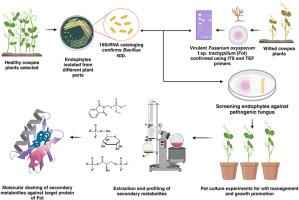Profiling the bioactive metabolites of endophytic Bacillus involved in antagonistic interaction with the Fusarium pathogen of cowpea
IF 3.3
3区 农林科学
Q2 PLANT SCIENCES
引用次数: 0
Abstract
Fusarium wilt, caused by Fusarium oxysporum f. sp. tracheiphilum is a devastating disease that affects cowpea globally. Due to limitations and environmental concerns connected with the use of chemical fungicides, sustainable and eco-friendly alternatives, especially biocontrol with microbial agents have gained attention. Antagonistic bacterial endophytes that produce bioactive secondary metabolites can suppress pathogens, promote plant growth and induce systemic resistance, making them ideal choices for integrated disease management strategies. In this study, seventeen out of 38 endophytic bacteria isolated from cowpea demonstrated suppressive effect on the wilt pathogen. Bacillus velezensis CBRE5 and Bacillus amyloliquefaciens CBSE5 showed the highest mycelial growth inhibition. In vivo, their combined application significantly reduced wilt incidence and enhanced plant growth by improving yield. These two isolates were selected for GC-MS analysis to identify key metabolites responsible for their growth-promoting and biocontrol effects. A wide range of compounds belonging to diverse classes were identified. Bioactive metabolites such as 3-methyl-2-phenylindole; benzaldehyde, 2-chloro-3,4-dibenzyloxy; 1H-1,2,3-triazole-4,5-dimethanol,1-(phenylmethyl); and carbamic acid, N-(4-acetylphenyl), (3-tetrahydrothienyl) ester were recognized as potential antifungal agents. Docking studies further highlighted the interactions among these metabolites and four virulent protein targets of the pathogen. Among these, elongation factor 1-alpha exhibited the strongest interaction with 3-methyl-2-phenylindole (binding affinity −7.7 kcal/mol), followed by galacturonan 1,4-alpha-galacturonidase (binding affinity −7.4 kcal/mol). Benzaldehyde (2-chloro-3,4-dibenzyloxy) also displayed dual functional potential, effectively targeting elongation factor 1-alpha and endo-polygalacturonase. These in silico results are preliminary and serve to generate hypotheses about possible mechanisms of action of endophytic Bacillus. The findings support the biocontrol potential of endophytic Bacillus spp., providing a basis for their future application as eco-friendly agents in managing Fusarium wilt of cowpea.

豇豆镰刀菌与内生芽孢杆菌拮抗作用的生物活性代谢产物分析
枯萎病是一种危害全球豇豆的毁灭性病害。由于使用化学杀菌剂的局限性和环境问题,可持续和生态友好的替代品,特别是微生物剂的生物防治受到了关注。拮抗细菌内生菌产生具有生物活性的次生代谢物,能够抑制病原菌,促进植物生长,诱导系统抗性,是病害综合治理策略的理想选择。从豇豆中分离到的38种内生细菌中,有17种对青枯病有抑制作用。对松解芽孢杆菌CBRE5和解淀粉芽孢杆菌CBSE5菌丝生长抑制作用最强。在体内,它们的组合施用显著降低了枯萎病的发病率,并通过提高产量来促进植株生长。选择这两个分离株进行气相色谱-质谱分析,以确定其促进生长和生物防治作用的关键代谢物。鉴定出了属于不同类别的广泛化合物。生物活性代谢物,如3-甲基-2-苯基吲哚;苯甲醛、2-chloro-3 4-dibenzyloxy;1 h - 2 3-triazole-4 5-dimethanol 1 - (phenylmethyl);氨基甲酸、N-(4-乙酰苯基)、(3-四氢噻吩基)酯被认为是潜在的抗真菌药物。对接研究进一步强调了这些代谢物与病原体的四个毒力蛋白靶点之间的相互作用。其中,延伸因子1- α与3-甲基-2-苯基吲哚的相互作用最强(结合亲和力- 7.7 kcal/mol),其次是半乳糖醛酸酶1,4- α -半乳糖醛酸酶(结合亲和力- 7.4 kcal/mol)。苯甲醛(2-氯-3,4-二苯甲氧基)也显示出双重功能潜力,有效靶向延伸因子1- α和内切聚半乳糖醛酸酶。这些硅结果是初步的,并有助于产生关于内生芽孢杆菌可能的作用机制的假设。研究结果支持了内生芽孢杆菌的生物防治潜力,为其作为生态友好型药剂在豇豆枯萎病防治中的应用奠定了基础。
本文章由计算机程序翻译,如有差异,请以英文原文为准。
求助全文
约1分钟内获得全文
求助全文
来源期刊
CiteScore
4.30
自引率
7.40%
发文量
130
审稿时长
38 days
期刊介绍:
Physiological and Molecular Plant Pathology provides an International forum for original research papers, reviews, and commentaries on all aspects of the molecular biology, biochemistry, physiology, histology and cytology, genetics and evolution of plant-microbe interactions.
Papers on all kinds of infective pathogen, including viruses, prokaryotes, fungi, and nematodes, as well as mutualistic organisms such as Rhizobium and mycorrhyzal fungi, are acceptable as long as they have a bearing on the interaction between pathogen and plant.

 求助内容:
求助内容: 应助结果提醒方式:
应助结果提醒方式:


